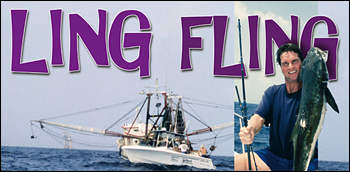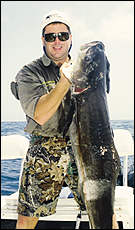
Ling, cobia or lemonfish, by any name
they're world-class fighters.
By Chester Moore, Jr.
Page 2
A friend of mine who pursues ling a lot says he learned that lesson when he was toying around with a big ling that kept coming up to his boat. The big fish simply wanted nothing to do with his offering of cut pogey on a 7/0 hook and 50-pound-test line, but when he grabbed a medium action spinning combo spooled with 15-pound-test and rigged the same bait he got hooked up immediately. The big fish seemed to be aware of the heavier line.
If you would like to catch ling (along with shark, king mackerel and other species) try the standard summer fishing protocol: a steady stream of chum, and live crab or fresh cut bait hanging from circle hooks. Crabs in particular are extremely good baits for ling. Almost every ling I have ever cleaned or seen cleaned had a belly full of crabs.
Rods loaded with artificials should also be kept within reach since ling don't mind biting on plastic. Soft plastics like curl-tailed grubs or imitation ribbonfish are good baits for lings. One of my favorite baits is the big 6-inch D.O.A. shrimp in brown or chartreuse. Using chartreuse is interesting because most of the offshore guides in Florida swear by it. A popular ling bait in Florida is an 8-inch chartreuse curl-tailed grub dressed out with a sparkled pink skirt. Guides there claim a ling can't resist it. Hard plastics like shallow-running MirrOlures and Jointed Thundersticks can also be productive.
The ling themselves are fascinating creatures to study. Their moves baffle the scientific and angling communities.
 It's well known that they travel south to north in the spring and north to south in the fall. But ling are also found in deeper offshore water holding around structure throughout the year. Some scientists believe there is an additional offshore to inshore and back movement. Ling usually start showing up in Texas waters when Gulf waters reach 67 degrees and usually stick around until the big northers of fall move through. It's well known that they travel south to north in the spring and north to south in the fall. But ling are also found in deeper offshore water holding around structure throughout the year. Some scientists believe there is an additional offshore to inshore and back movement. Ling usually start showing up in Texas waters when Gulf waters reach 67 degrees and usually stick around until the big northers of fall move through.
There is strong evidence to suggest that some ling may bond to a given piece of structure or come back to it every year. One of the best examples of this behavior of ling is often cited by Joe Persohn of Beaumont. Persohn has a story he likes to tell about one particular ling that has fooled him on many occasions.
"At one rig, I have encountered what I feel to be the same ling on every trip for two summers," he says. "She's about 50 pounds, hangs around the same platform leg and will come up to the boat. As a matter of fact, she comes so close that I could gaff her."
Tagging studies initiated several years ago show this ling might actually be coming back to the same rig. Out of several hundred tagged in the northern Gulf, 55 were recaptured the next year and 12 of them were caught in the exact same spot where they were initially caught.
That means the big ling you just never could get to cooperate last summer might be hanging around that very same buoy or rig you saw it at last year. If you happen to be in the neighborhood, you might want to see if it's hanging around and if it's hungrier than it was last time around. But don't be surprised if that ling inhales your bait and spits it right back out before you can set the hook.
Ling may not look or act like other fish, but they're no dummies.
# # # #
page 1 / page 2
| 




